Toyota RAV4 (XA40) 2013-2018 Service Manual: Rear shock absorber
Components
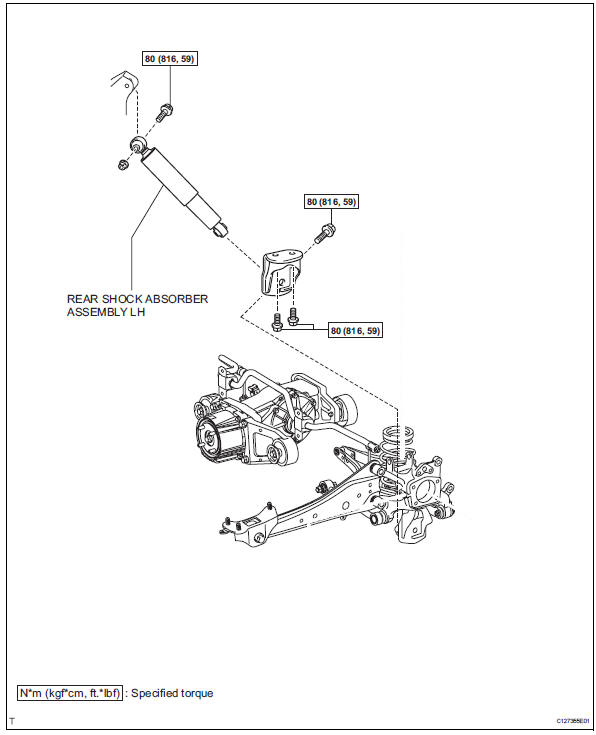
Removal
Hint
- Use the same procedures for the rh side and lh side.
- The procedures listed below are for the lh side.
- Remove rear wheel
- Remove rear shock absorber assembly lh
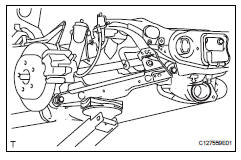
- Support the no. 2 Suspension arm lh with a jack.
Notice:
Place a wooden or rubber block between the jack and arm.
- Remove the bolt and 2 nuts from the suspension member and axle carrier.
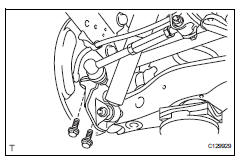
- Remove the 2 bolts and disconnect the shock absorber with the bracket.
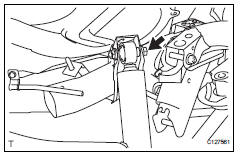
- Remove the nut and bolt from the shock absorber upper side.
- Remove the shock absorber from the vehicle.
- Remove the nut and bolt from the bracket.
Hint:
While fixing the nut in place, loosen and remove the bolt.
Inspection
- Inspect rear shock absorber assembly lh
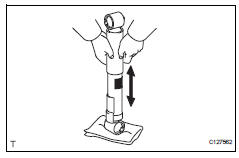
- Compress and extend the shock absorber rod, and
check that there is no abnormal resistance or
unusual sound during operation.
If there is any abnormality, replace the shock absorber with a new one.
Notice:
When disposing of the shock absorber, see disposal (see page sp-37).
Installation
Hint:
- Use the same procedures for the rh side and lh side.
- The procedures listed below are for the lh side.
- Temporarily install rear shock absorber assembly lh
- Temporarily install the bracket to the shock absorber with the bolt and nut.
Notice:
Fix the nut in place and temporarily install the bolt.
- Temporarily install the shock absorber upper side to the suspension member with the bolt and nut.
Notice:
Fix the nut in place and temporarily install the bolt.
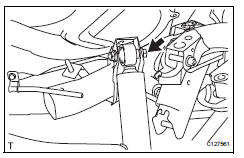
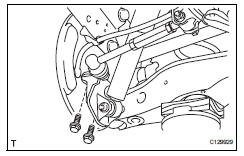
- Install the shock absorber with the 2 bolts to the axle carrier.
Torque: 80 n*m (816 kgf*cm, 59 ft.*Lbf)
- Temporarily install the suspension arm with the bolt and 2 nuts to the suspension member and axle carrier.
- Temporarily install rear upper control arm assembly lh (see page sp-40)
- Install rear wheel torque: 103 n*m (1,050 kgf*cm, 76 ft.*Lbf)
- Stabilize suspension
- Lower the vehicle.
- Press down on the vehicle several times to stabilize the suspension.
- Tighten rear shock absorber assembly lh
- Fix the nut in place and tighten the bolt.
Torque: 80 n*m (816 kgf*cm, 59 ft.*Lbf)
- Inspect and adjust rear wheel alignment
- Inspect and adjust the rear wheel alignment (see page sp-7).
Disposal
- Dispose of rear shock absorber assembly lh
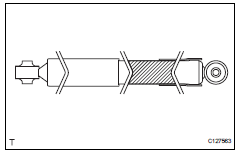
- Fully extend the shock absorber rod, and clamp it in a vise at an angle.
- Using a drill, make a hole near the center of the cylinder in the hatched area shown in the illustration to discharge the gas inside.
Caution:
As metal debris may be blown outward by the gas, you must:
- Wear protective glasses.
- Cover the area being cut.
Notice:
The gas is colorless, odorless and harmless
 Rear coil spring
Rear coil spring
Components
Removal
Hint:
Use the same procedures for the rh side and lh side.
The procedures listed below are for the lh side.
Remove rear wheel
Remove skid control sensor wire (fo ...
 Rear upper control arm
Rear upper control arm
Components
Removal
Hint:
Use the same procedures for the rh side and lh side.
The procedures listed below are for the lh side.
Remove rear wheel
Disconnect skid control sensor wire ...
Other materials:
Vehicle load limits
Vehicle load limits include total load capacity, seating capacity,
twr (trailer weight rating) and cargo capacity.
Total load capacity (vehicle capacity weight)
Total load capacity means the combined weight of occupants, cargo
and luggage.
Seating capacity: 5 occupants (front 2, rear 3)
Seatin ...
Air-fuel ratio (a/f) and heated oxygen (ho2) sensor
monitors (active air-fuel ratio control type)
Preconditions
The monitor will not run unless:
2 Minutes or more have elapsed since the engine
was started.
The engine coolant temperature (ect) is 75°c
(167°f) or more.
Cumulative driving time at a vehicle speed of 48
km/h (30 mph) or more exceeds 6 minutes.
Air-fuel rat ...
Only driver door lock / unlock functions do not operate
Description
The main body ecu receives lock / unlock switch signals and activates the
door lock motor accordingly.
Wiring diagram
Inspection procedure
Perform active test by intelligent tester (door lock)
Select the active test, use the intelligent tester to
generate a control c ...
